Bernese GNSS Software
Version 5.2
Tutorial
Processing Example
Introductory Course
Terminal Session
Rolf Dach, Peter Walser
August 2013
AIUB Astronomical Institute, University of Bern
�
�
Contents
1 Introduction to the Example Campaign
1.1 Stations in the Example Campaign . . . . . . .
1.2 Directory Structure . . . . . . . . . . . . . . . .
1.2.1 The DATAPOOL Directory Structure
. . . . . . . . . . . . . . .
. . . . . . . . . . . . . . .
. . .
1
1
3
. . . . . . . . . . . . . . .
4
1.2.2 The Campaign–Directory Structure . . .
. . . . . . . . . . . . . . .
1.2.3 Input Files for the Processing Examples . . . . . . . . . . . . . . .
. . . . . . . . . . . . . . .
1.2.4 The SAVEDISK Directory Structure . . .
2 Terminal Session: Monday
. . . . . . . . . . . . . . . . . . . . . . . .
2.1 Start the Menu . . . . . . . . .
. . . . . . . . . . . . . . . . . . . . . . . .
2.2 Select Current Session . . . . .
. . . . . . . . . . . . . . . . . . . . . . . .
2.3 Campaign Setup . . . . . . . .
. . . . . . . . . . . . . . . . . . . . . . . .
2.4 Menu Variables . . . . . . . . .
2.5 Generate A Priori Coordinates . . . . . . . . . . . . . . . . . . . . . . . .
2.6 Importing the Observations . . . . . . . . . . . . . . . . . . . . . . . . . .
2.7 Daily Goals . . . . . . . . . . .
. . . . . . . . . . . . . . . . . . . . . . . .
3 Terminal Session: Tuesday
3.1 Prepare Pole Information . . . . . . . . . . . . .
3.2 Generate Orbit Files . . . . . . . . . . . . . . . .
3.3 Data Preprocessing (I)
. . . . . . . . . . . . . . .
. . . . . . . . . . . . . .
. . . . . . . . . . . . . .
. . . . . . . . . . . . . .
. . . . . . . . . . . . . .
3.3.1 Receiver Clock Synchronization . . . . . .
3.3.2 Form Baselines . . . . . . . . . . . . . . .
. . . . . . . . . . . . . .
3.3.3 Preprocessing of the Phase Baseline Files . . . . . . . . . . . . . .
. . . . . . . . . . . . . .
3.4 Daily Goals . . . . . . . . . . . . . . . . . . . . .
4 Terminal Session: Wednesday
4.1 Data Preprocessing (II)
4.2 Produce a First Network Solution . . . . . . . . . . . . . . . . . .
4.3 Ambiguity Resolution . . . . . . . . . . . . . . . . . . . . . . . .
. . . . . . . . . . . . . . . . . . . . . . .
4.3.1 Ambiguity Resolution: Quasi–Ionosphere–Free (QIF) . . .
4.3.2 Ambiguity Resolution: Short Baselines . . . . . . . . . . .
4.3.3 Ambiguity Resolution: Bernese Processing Engine (BPE)
4.3.4 Ambiguity Resolution: Summary . . . . . . . . . . . . . .
4.4 Daily Goals . . . . . . . . . . . . . . . . . . . . . . . . . . . . . .
5 Terminal Session: Thursday
5.1 Final Network Solution . . . . . . . . . . . . . .
. . . . . . . . . . . . . . .
5.2 Check the Coordinates of the Fiducial Sites . . . . . . . . . . . . . . . .
.
5.3 Check the Daily Repeatability . . . . . . . . . .
. . . . . . . . . . . . . . .
5.4 Compute the Reduced Solution of the Sessions . . . . . . . . . . . . . .
5.5 Velocity Estimation . . . . . . . . . . . . . . . .
. . . . . . . . . . . . . . .
. . . . .
. . . . .
. . . . .
. . . . .
. . . . .
. . . . .
. . . . .
. . . . .
.
6
7
10
11
11
11
12
12
14
16
19
21
21
23
30
30
34
37
40
41
41
49
53
53
62
65
69
71
73
73
78
85
87
91
PageI
�
Contents
5.6 Daily Goals . . . . . . . . . . . . . . . . . . . . . . . . . . . . . . . . . . .98
6 Additional Examples
6.1 Preparing Combined GPS and GLONASS IGS–Orbits . . . . . . . . . .
6.2 Kinematic Positioning . . . . . . . . . . . . . . . . . . . . . . . . . . . .
6.3 Zero Difference Processing for Clock Estimation . . . . . . . . . . . . .
.
6.1.1 Prepare Pole Information . . . . . . . . . . . . . . . . . . . . . .
6.1.2 Merging Precise Orbit Files . . . . . . . . . . . . . . . . . . . . .
6.1.3 Generating Standard Orbit Files . . . . . . . . . . . . . . . . . .
99
99
99
100
101
105
6.2.1 Estimating Kinematic Positions in a Double–Difference Solution . . 105
109
6.2.2 Extracting the Program Output from a Kinematic Positioning . . .
110
.
6.2.3 Further suggestions . . . . . . . . . . . . . . . . . . . . . . . . . .
.
110
111
.
115
.
122
.
.
130
6.4 Simulation of Global Navigation Satellite Systems (GNSS) Observations . 131
131
6.4.1 Simulation of GNSS Observations . . . . . . . . . . . . . . . . . .
.
6.4.2 Zero Difference Solution from Simulated GNSS Observations . . .
134
6.4.3 Double–Difference Solution from Simulated GNSS Observations . . 138
6.4.4 Final Remarks . . . . . . . . . . . . . . . . . . . . . . . . . . . .
142
6.3.1 Preprocessing . . . . . . . . . . . . . . . . . . . . . . . . . . . . .
6.3.2 Residual Screening . . . . . . . . . . . . . . . . . . . . . . . . . .
6.3.3 Generate Clock Solutions . . . . . . . . . . . . . . . . . . . . . .
6.3.4 Further suggestions . . . . . . . . . . . . . . . . . . . . . . . . . .
.
.
.
.
.
.
PageII
AIUB
�
1 Introduction to the Example Campaign
1.1 Stations in the Example Campaign
Data from thirteen European stations of the International GNSS Service (IGS) net-
work and from the EUREF Permanent Network (EPN) were selected for the example
campaign.
They are listed in Table 1.1. The locations of these stations are given
in Figure 1.1. Three of the stations support only Global Positioning System (GPS)
whereas all other sites provide data from both GPS and its Russian counterpart
Globalьna
sistema: Global Navigation Satellite Sys-
tem (GLONASS).
navigacionna
sputnikova
The observations for these stations are
available for four days. Two days in year
2010 (day of year 207 and 208) and two
in 2011 (days 205 and 206).
In the ter-
minal sessions you will analyze the data
in order to obtain a velocity field based
on final products from Center for Orbit
Determination in Europe (CODE).
For
eight of these stations, coordinates and
velocities are given in the IGb08 refer-
ence frame, an IGS–specific
realization
of the ITRF2008
(see ${D}/STAT_LOG/
IGb08.snx).
,
ONSA
PTBB
WTZZ
WTZR
LAMA
JOZ2
GANP
WSRT
HERT
ZIM2
ZIMM
TLSE
MATE
have been
Receiver is tracking
GPS/GLONASS
Station with coordinates/velocities in IGb08
Between these days in 2010 and 2011
the receivers (LAMA, TLSE, WTZR) and
the full equipment (WTZZ)
changed.
The receiver type, the antenna
type, and the antenna height are also pro-
vided in Table 1.1. Notice, that for three
antennas (GANP, WTZR, ZIM2) values
from an individual calibration are available
For all other antennas only type–specific calibration results
from the EPN processing.
from the IGS processing (${X}/GEN/IGS08.ATX) are available. More details are provided
in Table 1.2. Only in two cases where no calibration of the antenna/radome combination
was available (ONSA, WSRT) the calibration values of the antenna without radome were
used instead. With one exception (ONSA) even system–specific calibrations for GPS and
GLONASS measurements are available.
Figure 1.1: Stations used in example campaign
GPS−only
The distances between stations in the network are between 200 and 1000 km.
are two pairs of receivers at one site included in the example dataset:
the distance between ZIMM and ZIM2 is only 19 m.
In Kötzting the receivers WTZR
in Zimmerwald,
There
Page1
�
1IntroductiontotheExampleCampaign
Table 1.1: List of stations used for the example campaign including receiver and antenna type
as well as the antenna height.
Station name
GANP11515M001Ganovce, Slovakia
Location
HERT 13212M010 Hailsham,
United Kingdom
JOZ2 12204M002 Jozefoslaw, Poland
Antenna
Receiver type
Antenna type Radome height
TRIMBLE NETR8
TRM55971.00 NONE
LEICA GRX1200GGPRO
LEIAT504GG
LEICA GRX1200GGPRO
LEIAT504GG
NONE
NONE
0.0000 m
0.3830 m
0.0000 m
LAMA12209M001Olsztyn, Poland
2010: LEICA GRX1200GGPRO
LEIAT504GG
LEIS
2011: LEICA GRX1200+GNSS
MATE12734M008 Matera, Italy
ONSA10402M004Onsala, Sweden
PTBB 14234M001 Braunschweig, Germany
0.0600 m
0.0600 m
0.1010 m
0.9950 m
LEIS
NONE
LEIAT504GG
LEICA GRX1200GGPRO
LEIAT504GG
JPS E_GGD
AOAD/M_B
ASHTECH Z–XII3T
ASH700936E
OSOD
SNOW 0.0562 m
TLSE 10003M009 Toulouse, France
2010: TRIMBLE NETR5
WSRT 13506M005Westerbork,
The Netherlands
TRM59800.00 NONE
1.0530 m
2011: TRIMBLE NETR9
TRM59800.00 NONE
AOA SNR–12 ACT
AOAD/M_T
DUTD
1.0530 m
0.3888 m
WTZR 14201M010Kötzting, Germany
2010: LEICA GRX1200GGPRO
WTZZ 14201M014Kötzting, Germany
ZIM2 14001M008 Zimmerwald, Switzerland
ZIMM14001M004Zimmerwald, Switzerland
LEIAR25.R3
LEIT
0.0710 m
2011: LEICA GRX1200+GNSS
LEIAR25.R3
2010: TPS E_GGD
LEIT
0.0710 m
TPSCR3_GGD CONE
0.2150 m
2011: JAVAD TRE_G3TH DELTA
LEIT
LEIAR25.R3
TRIMBLE NETR5
TRM59800.00 NONE
TRIMBLE NETRS
TRM29659.00 NONE
0.0450 m
0.0000 m
0.0000 m
Page2
AIUB
�
OS
Antenna type
AOAD/M_B
OD
AOAD/M_T
TD
ASH700936E SNO
W
LEIAR25.R3 LEIT
DU
LEIAT504GG NON
E
ROBOT
ROBOT
ROBOT
ROBOT
ROBOT
ROBOT
used at
stations
ONSA
WSRT
PTBB
WTZR,
WTZZ(2011)
JOZ2, HERT,
MATE
LAMA
WTZZ(2010)
ZIMM
GANP
TLSE, ZIM2
—
—
ROBOT
ROBOT
ROBOT
ROBOT
—
ROBOT
ROBOT
Table 1.2: List of antenna/radome combinations used in the example campaign together with
the available antenna calibration values in IGS08 model.
1.2DirectoryStructure
Type of calibration
for GLONASS
ADOPTED from GP
for GPS
ADOPTED from NONE
S
ADOPTED from NONE
ROBOT
ROBOT
LEIAT504GG LEIS
TPSCR3_GGD CO
and WTZZ are separated by less than 2 m — this is a short GPS/GLONASS base-
NE
line.
TRM29659.00 NON
E
TRM55971.00 NON
E
TRM59800.00 NON
E
The receivers used at the stations MATE, ONSA, PTBB, and WSRT are connected to
H-Maser clocks. The receiver type ASHTECH Z-XII3T used at PTBB was specifically
developed for time and frequency applications. In 2011 both receivers in Kötzting (WTZR
and WTZZ) were connected to the same H–Maser (EFOS 18).
1.2 Directory Structure
The data belonging to this example campaign is included in the distribution of theBernese
GNSSSoftware. Therefore, you may also use this document to generate solutions from
the example dataset to train yourself in the use of theBerneseGNSSSoftwareoutside the
environment of the BerneseIntroductoryCourse.
There are three areas relevant for the data processing (in the environment of the
Bernese Introductory Course they are all
tory):
located in the ${HOME}/GPSDATAdirec-
${D}: The DATAPOOL area is intended as an interface where all external files can be de-
posited after their download. It can be used by several processing campaigns.
${P}: The CAMPAIGN52 directory contains all processing campaigns for the Version 5.2 of
the BerneseGNSSSoftware.
groups use ${P}/INTRO in their ${HOME} directory.
In the BerneseIntroductoryCourseenvironment all
${S}: The SAVEDISK area shall serve as a product database where the result files from
different processes/projects can be collected and archived. At the beginning it only
contains reference files (*.*_REF) obtained with the example BPE from the distri-
bution.
BerneseGNSSSoftware,Version5.2
Page3
�
1IntroductiontotheExampleCampaign
1.2.1 The DATAPOOL Directory Structure (${D})
Motivation for the DATAPOOL area
The idea of the DATAPOOL area is to place local copies of external files somewhere on your
filesystem.
starting the processing:
It has several advantages compared to downloading the data each time when
· The files are downloaded only once, even if they are used for several campaigns.
· The data download can be organized with a set of scripts running independently from
the Bernese GNSS Software environment, scheduled by the expected availability of
the external files to download.
· The processing itself becomes independent from the availability of external data
sources.
Structure and content of the DATAPOOL area
The DATAPOOL area contains several subdirectories taking into account the different po-
tential sources of files and their formats:
RINEX :
The data of GNSS stations is provided in Receiver INdependent EXchange for-
mat (RINEX) files. The directory contains observation (Hatanaka–compressed) and
navigation (GPS and GLONASS) files. These RINEX files are “originary” files that
are not changed during the processing.
The RINEX files can be downloaded from international data centers. Project–specific
files are copied into this area.
If you mix the station lists from different projects,
take care on the uniqueness of the four–character IDs of all stations in the RINEX
file names.
HOURLY :
The same as the RINEX directory but dedicated to hourly RINEX data as used for
near real–time applications. Note: not all stations in this example provide hourly
RINEX files.
LEO :
This directory is intended to host files which are necessary for Low Earth Orbiter
(LEO) data processing. RINEX files are stored in the subdirectory RINEX (of the LEO
directory). The corresponding attitude files are placed in the subdirectory ATTIT.
These files are needed to run the example BPE on LEO orbit determination (LEOPOD.
PCF). They are not used in the example during the BerneseIntroductoryCourse.
SLR_NP :
The Satellite Laser Ranging (SLR) data is provided in the quicklook normal point
format. The directory contains the normal point files downloaded from the Interna-
tional Laser Ranging Service (ILRS) data centers.
These files are needed to run the example BPE on validating orbit using SLR ob-
servations (SLRVAL.PCF). They are not used in the example during the Bernese
IntroductoryCourse.
Page4
AIUB
�
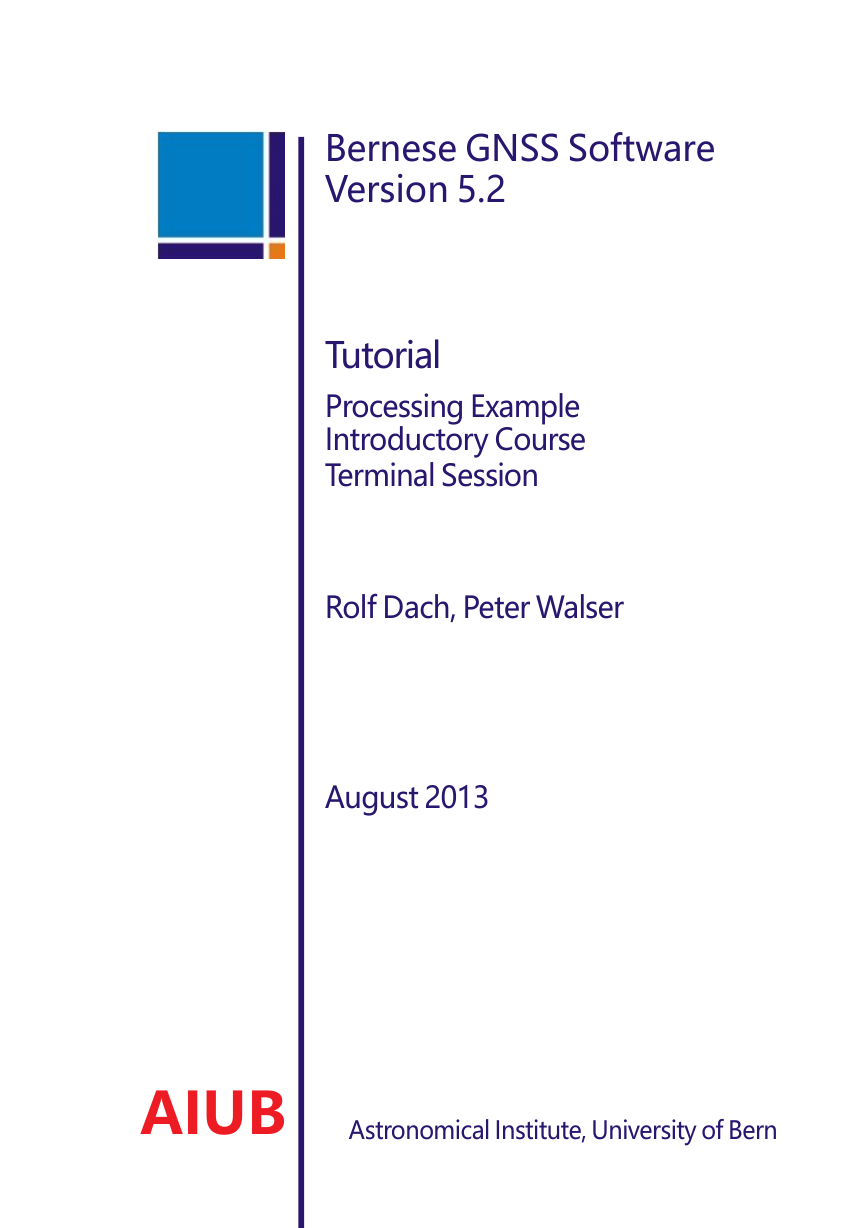

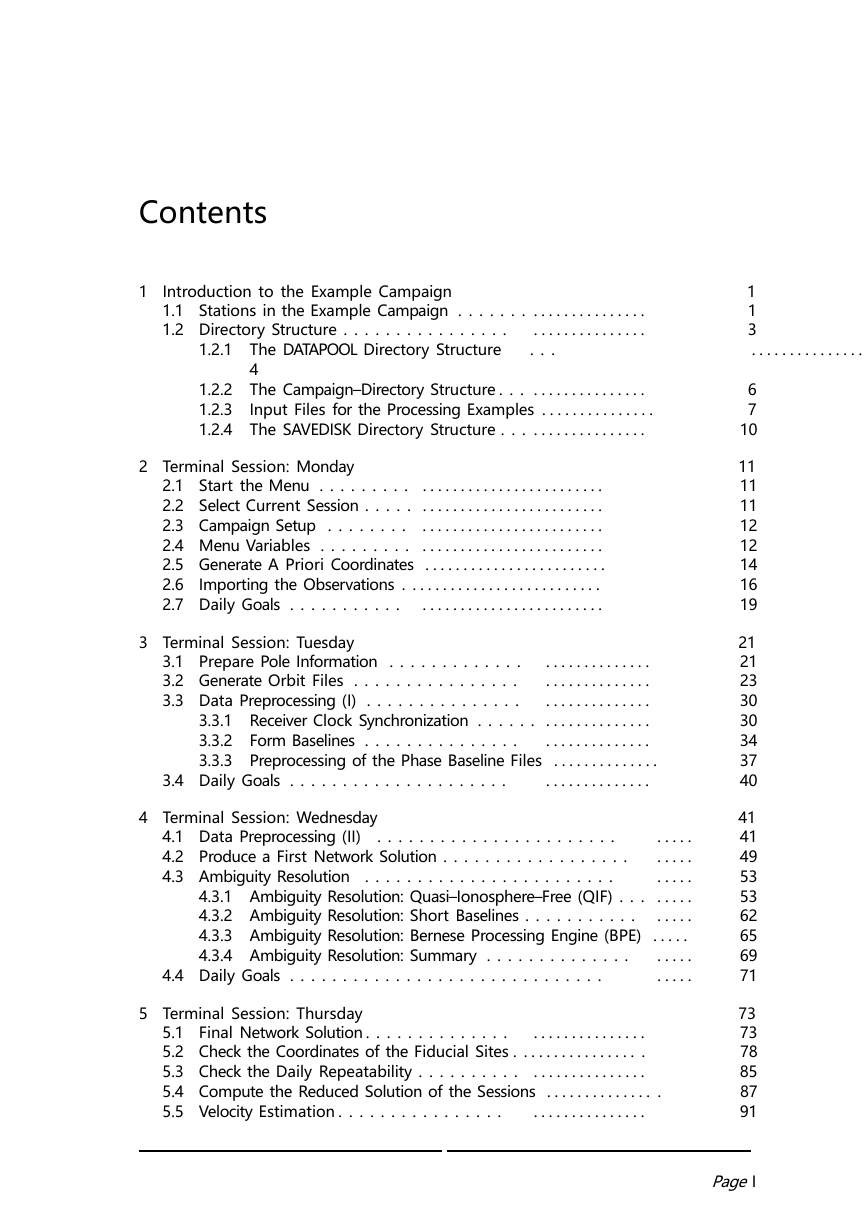
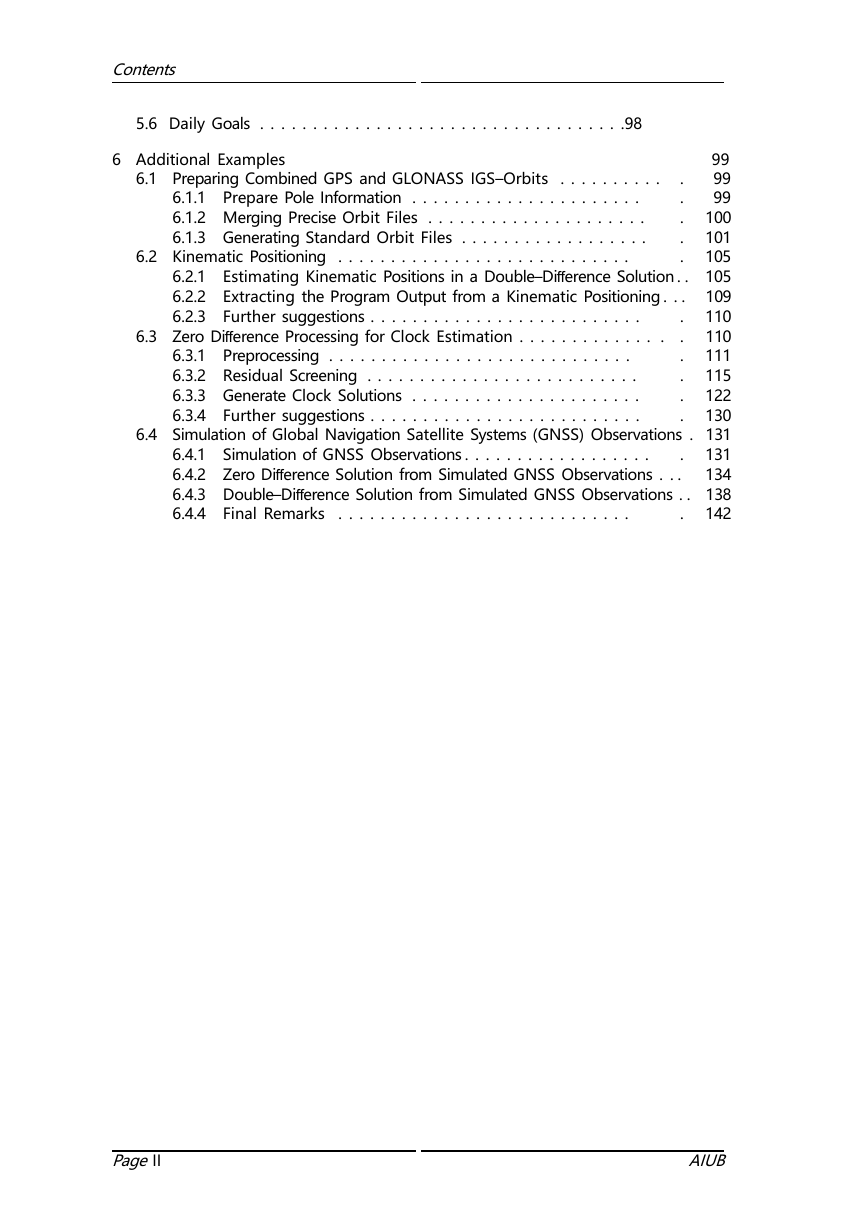
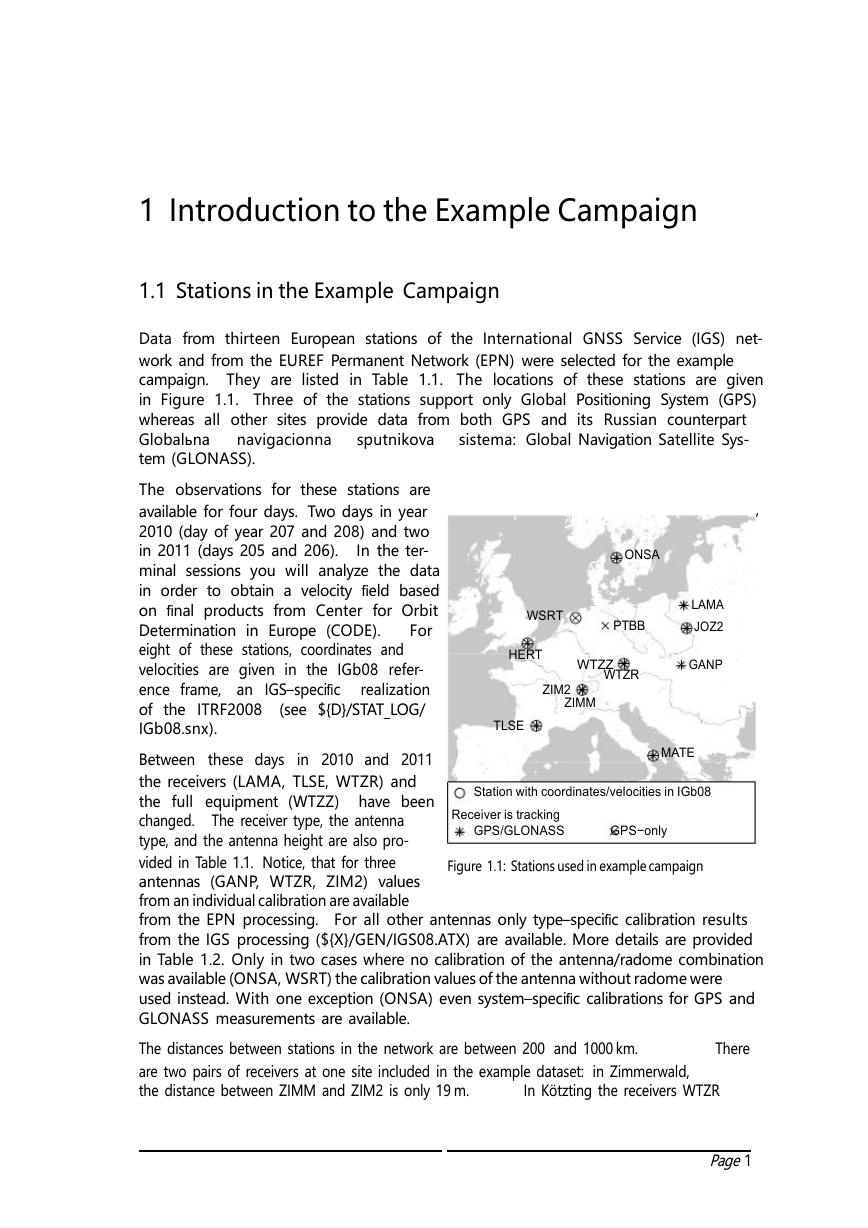
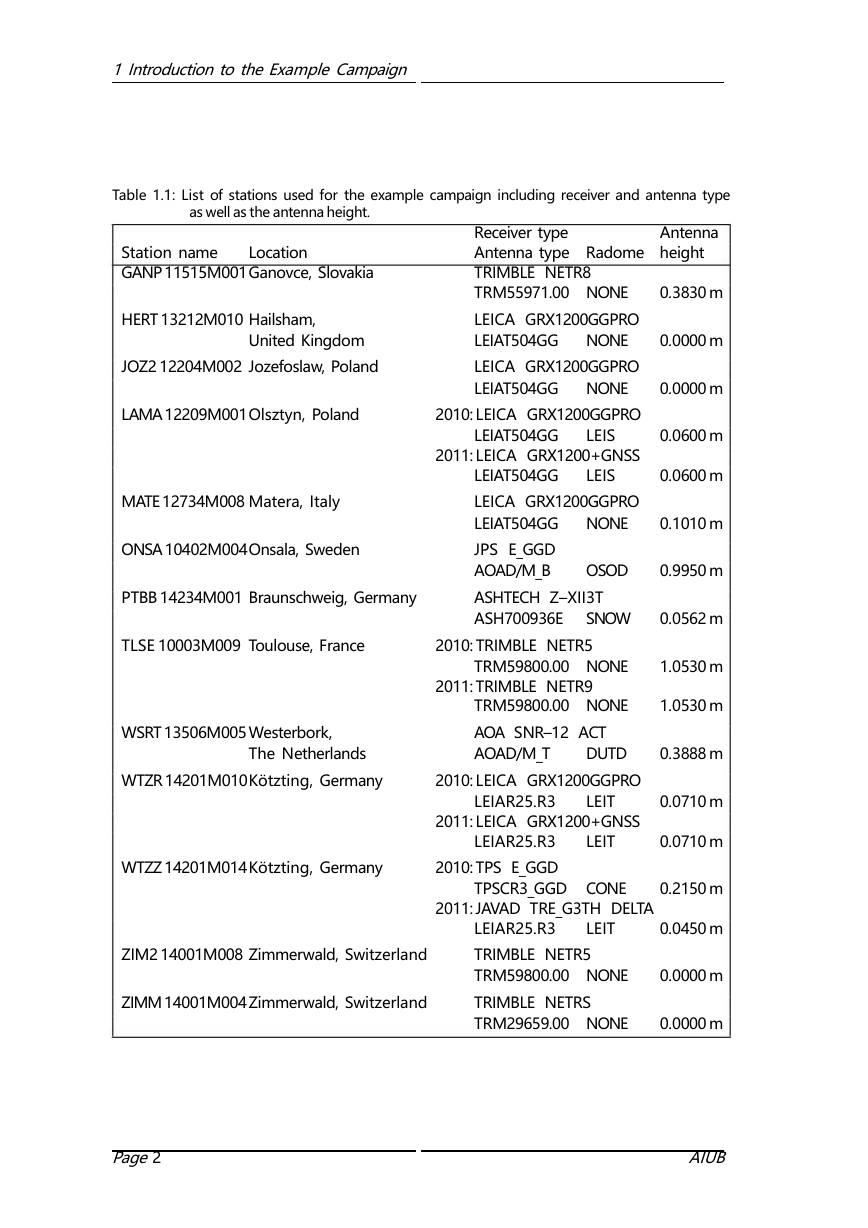
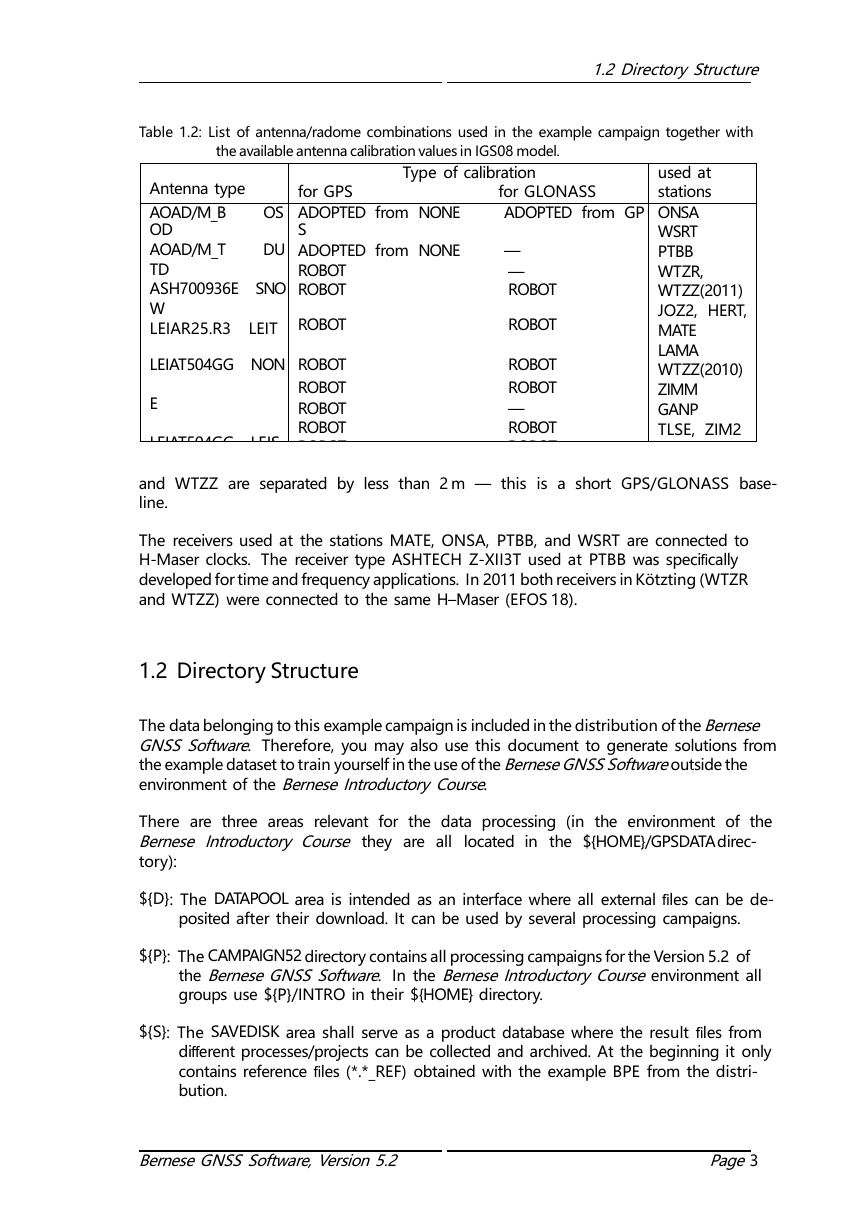
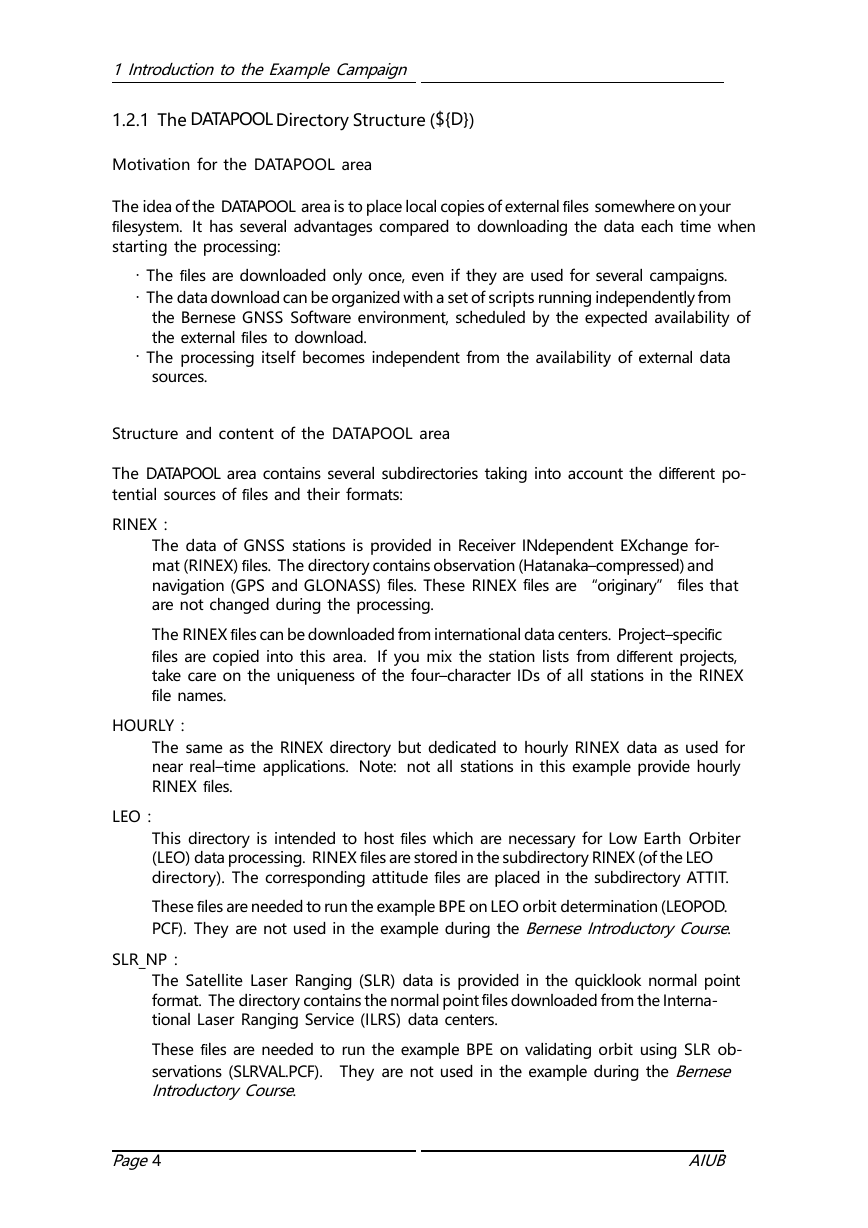








 2023年江西萍乡中考道德与法治真题及答案.doc
2023年江西萍乡中考道德与法治真题及答案.doc 2012年重庆南川中考生物真题及答案.doc
2012年重庆南川中考生物真题及答案.doc 2013年江西师范大学地理学综合及文艺理论基础考研真题.doc
2013年江西师范大学地理学综合及文艺理论基础考研真题.doc 2020年四川甘孜小升初语文真题及答案I卷.doc
2020年四川甘孜小升初语文真题及答案I卷.doc 2020年注册岩土工程师专业基础考试真题及答案.doc
2020年注册岩土工程师专业基础考试真题及答案.doc 2023-2024学年福建省厦门市九年级上学期数学月考试题及答案.doc
2023-2024学年福建省厦门市九年级上学期数学月考试题及答案.doc 2021-2022学年辽宁省沈阳市大东区九年级上学期语文期末试题及答案.doc
2021-2022学年辽宁省沈阳市大东区九年级上学期语文期末试题及答案.doc 2022-2023学年北京东城区初三第一学期物理期末试卷及答案.doc
2022-2023学年北京东城区初三第一学期物理期末试卷及答案.doc 2018上半年江西教师资格初中地理学科知识与教学能力真题及答案.doc
2018上半年江西教师资格初中地理学科知识与教学能力真题及答案.doc 2012年河北国家公务员申论考试真题及答案-省级.doc
2012年河北国家公务员申论考试真题及答案-省级.doc 2020-2021学年江苏省扬州市江都区邵樊片九年级上学期数学第一次质量检测试题及答案.doc
2020-2021学年江苏省扬州市江都区邵樊片九年级上学期数学第一次质量检测试题及答案.doc 2022下半年黑龙江教师资格证中学综合素质真题及答案.doc
2022下半年黑龙江教师资格证中学综合素质真题及答案.doc